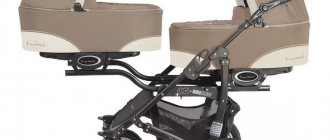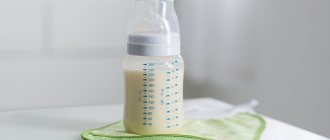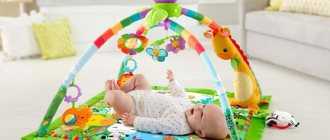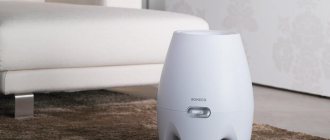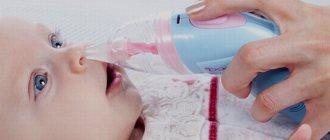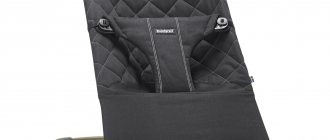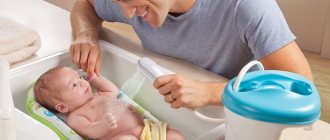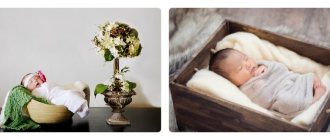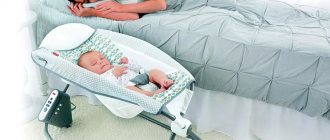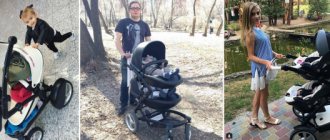Features of the powder composition
- Surfactants - surfactants are found in almost all powders; it is with their help that contaminants are washed off. Their harm to children's skin and body is also great, so you need to be vigilant. The permissible surfactant ratio in children's powder is 5-15%, no more.
- Soap base has a delicate effect on children's skin, thanks to its plant and animal origin.
- Enzymes – effectively remove fatty stains. When washed with water at 50°C, they lose their destructive properties.
- Bleach is necessary for washing children's clothes. The best option is to use oxygen bleach powder.
- Phosphates. Their purpose is to prevent scale in the washing machine. Phosphates are dangerous to the environment and living organisms. Their alternative in baby powder is sodium disilicate supplemented with zeolite.
Interesting: TOP 10 best cribs for newborns
How powders affect things
Among other things, Roskachestvo experts studied how powders affect washed items. Let us immediately note that all detected deficiencies are not violations. Products with them are simply deprived of the opportunity to qualify for the Russian Quality Mark.
For example, the test program included an indicator of the residue after ignition (ash content). The higher the percentage of ash content, the more minerals will be retained in the fabric - the fabric will coarse, become harder to the touch, as if starched. This is especially undesirable for children's delicate skin. The Roskachestvo standard has established that ash content should be no higher than 2%. Baby powders from 18 brands met this requirement. Amway
Home
powder has zero ash content .
It does not make the washed items rough at all. For two brands of products, the ash content was slightly higher than two percent, and for two other brands it was unacceptably higher. We are talking about Free Time
(6.4%) and
“Mara”
(4.6%) powders. Most likely, things washed with these powders will begin to become rough over time.
After 25 washes at a water temperature of 40°C, things turned gray only in one case (when washed with Molecola
) and in none of them did they turn yellow (although in two cases yellowing was possible over time, with more washings).
In addition, things did not shrink after washing (they did not change sizes after washing and drying) and did not lose strength either in width or length. More details can be found in the product cards HERE
. Note that the powders studied, not for children's underwear, damaged the fabric more. Thus, one of the powders reduced the strength of items after 25 washes by 45%!
Also, when studying children's powders, most of them showed a “blueing” effect, and in the powder of one TM it turned out to be the most pronounced. That is, many things visually seemed fresher after washing.
Tests on the effect of the powder on the loss of color of things were carried out on samples of knitted fabrics in red, crimson, black, blue and mustard colors. As a result, after 15 washes at 40°C with Aistenok
,
“Spring Tenderness”
,
“Mara”
,
“Eared Nanny”
,
“I Was Born”
,
Burti
,
Frosch
and
Reflect
samples of all colors retained their bright colors . After washing with other powders, some or all of the colors faded partially or completely.
As we can see, there was also an egregious case when the powder irreversibly damaged the samples. We are talking about the product TM Garden
. You can compare photos of samples before and after washing with this product.
We also assessed how the color of items previously “aged” (that is, washed 25 times at 60 °C with universal powder) would change after washing with baby powders. Interestingly, the mustard color of the samples was restored in 11 cases. In one case, the red color of the sample was restored. Well, in three cases we encountered an even greater loss of color. Garden again
,
Molecola
and
Sodasan
. Note that these powders are “eco-friendly” and are made from soap.
Soap products, as it turned out, really spoil the color of things.
But after 15 washes at 40 °C, no pilling appeared on clothes washed with all the powders tested. You can safely wash even knitwear, because it is more susceptible to their formation than other materials.
What powder is best for washing children's clothes?
Of course, before buying powder for your child, mom or dad pays attention to its composition. After all, the baby’s delicate skin needs special care. Therefore, you should always pay attention to what components the detergent is made from. It is best that there are no phosphates and chlorine, and there are no synthetic components or flavored additives. It is preferable to wash children's clothes with the powder that suits your child and meets his financial capabilities. But it would be better if the detergent was of excellent quality, and this, as a rule, is not always cheap. But, as they say, they don’t skimp on health. If your baby develops a rash or other allergy symptoms, you should immediately stop using the product and contact your pediatrician. After all, health is a fragile thing, and it is the most valuable thing a person has.
Can baby powder break a washing machine?
Tap water and tap water are very hard due to the excess of mineral salts in it: calcium and magnesium. These hardness salts remain on the heating elements of household appliances (kettles, coffee machines, dishwashers), forming scale on them - we find it at the bottom of the kettle in the form of a white coating. The washing machine is no exception. Scale can accumulate on the heating element, and the machine will break down and burn out. In turn, certain components of the laundry detergent promote the growth of such deposits, which increases the likelihood of breakdown.
To reduce the risk of burnout, it is better to use washing powders that deposit a small amount of salts on the heating elements of the machine. These are the majority among the studied children's powders. Aistenok brand.
,
“Dosenka”
,
“Mara”
,
“Spring Tenderness”
,
“Eared Nanny”
,
The Seagull”
,
“I Was Born”
,
BabySpeci
,
Burti
,
Frosch
,
Garden
,
Meine LIEBE
,
PoshOne
and
Tobbi Kids
.
How to protect your washing machine from this and other breakdowns, read HERE
.
We also checked how many organic compounds baby powders leave on the drum of the machine. It turned out that only two powders left too much of them. These are again eco-friendly soap powders from Molecola and Sodasan. Interestingly, the packaging of Sodasan powder states that it “Protects against the formation of limescale.”
How to wash clothes for newborns before the maternity hospital
New clothes look attractive and keep their shape thanks to the starch and other means with which they are processed. Before you put new clothes on your baby, you need to wash them.
You can prepare things for a baby in the maternity hospital in several stages:
- Remove tags and remove labels. Be careful not to damage the fabric.
- Soak the items in a bowl of warm water for a short time and rinse by hand. You can use special tools.
- Change the water several times when rinsing.
In an automatic machine, you need to wash clothes for a newborn as follows:
- Place items without labels in the drum separately from other clothes.
- Select short wash cycle. Set the temperature to 40 degrees.
- Use the extra rinse function.
After cleaning, shake and dry items on the line. Iron from the wrong side and carefully fold the diapers and vests into a pre-prepared place.
At what temperature should I wash?
Natural cotton fabrics can be washed at temperatures up to 90 degrees. This is the optimal mode for white items made of thick material. Colored undershirts and rompers will become discolored during high-grade processing. For such fabrics, a mode at 40 degrees is suitable. Delicate materials such as silk and wool are best processed at 30 degrees to prevent fabric shrinkage.
What mode should I wash on?
The clothing manufacturer leaves care instructions on the tag. Pay attention to the temperature conditions indicated there. The label also indicates whether a spin can be used.
Most machines are equipped with a “Hypoallergenic wash” mode. Use it to clean baby items. If this mode is not provided by the model, use an additional rinse. This will remove any remaining powder completely.
The best foreign products
Based on the composition of the products, expert recommendations and reviews of people who have been using them for a long time, the following rating of reliable foreign powders for baby laundry has been created:
1
Burti Hygiene (Germany)
Contains soap base and brighteners, does not contain phosphates. Hypoallergenic, economical, has a disinfecting effect. It is better to use for white and light-colored laundry, as colored clothes can bleach strongly. The cost of a pack weighing 1.1 kg is about 1 thousand rubles
Burti Hygiene
2
Tide children's (USA)
Contains extracts of chamomile and medicinal plant aloe. Suitable for sensitive skin, but it is better not to use the product for newborns. An economical package weighing 3 kg will cost 300–400 rubles
Tide for children
3
Babyline (Germany)
One of the best ingredients: oxygen bleach and soap base. Removes most stains even in cold water, does not cause reactions on the skin, and is used sparingly
The German product Babyline does not contain potentially hazardous components
4
Meine Liebe (Germany)
Does not contain phosphates, chlorine or fragrances. Shows good results when washed in cold water, copes with difficult stains on white and colored children's clothing. Dermatologist approved and wears off slowly even with frequent use
Meine Liebe
5
BioMio (Denmark)
Liquid laundry detergent with a natural, safe composition. Suitable for children's underwear, newborns and delicate fabrics of adult clothing. Can be used for hand washing, economical due to high concentration
BioMio
6
Amway (USA)
Effectively removes stains using natural enzymes. Can be rinsed out of fabric in 1 wash cycle, safe and hypoallergenic. The silicic acid salts in the composition prevent the formation of scale on the elements of the washing machine.
Amway
Popular plants for landscaping and decorating children's rooms and preschools. Recommended and prohibited (25 Photos & Videos) + Reviews
What is the difference between baby powder and regular powder?
It is impossible to distinguish between products for children's clothes and ordinary clothes by external signs.
Most powders are not completely washed out of the fabric after washing, even after 3-4 rinses. Residues of hazardous substances penetrate the child’s body through the skin and can cause allergic reactions or even poisoning.
The main difference between products for children and adults is the level of toxicity. It can only be tested in laboratory conditions using living cells.
In everyday life, washing powders for children and adults can be distinguished only by indirect signs. Thus, washing powder labeled “children’s” or “for children’s underwear” contains a lower concentration of surfactants (surfactants) compared to regular detergents. It is this component that causes irritation on the skin, remaining in the tissue structure for at least 3–4 days.
In an “adult” product, unlike a good children’s product, additives are additionally used for:
- color preservation
- imparting softness to fabrics
- removing tough stains
- easy ironing
- giving a pleasant aroma
